The Sunbeam Building is a showcase for how business and the arts can work together to breathe life into a neighborhood… and a community.
On a sunny Saturday morning in July, the corner of Main and Sheridan was humming with activity: the Prairie Traveling Vintage Show was in town! People arrived in cars, on bicycles and on foot as throngs of shoppers, vendors and curious onlookers milled about, spilling onto the sidewalks near the old Sunbeam Building. Inside the 22,000-square-foot warehouse, this self-described “band of retro-finding, vintage-selling, backroad-traveling gypsies” had set up for the day, making themselves at home alongside a range of like-minded retail outlets and artist studios.
“We were so excited,” exclaims building co-owner Steve Rouland. “There must have been a thousand people who came and went—a lot of people who might never have come here. And that goes back to how the arts affect traffic.”
Reimagined Space
For many years, the building at 925-933 North Sheridan was known for its baked goods, not for the arts or vintage antiques. Through most of the last century, city directories placed numerous bakeries inside—hence its name, after the famous Sunbeam brand. But in 2010, the 1930s-era warehouse sat empty and purposeless… that is, until it was purchased by Rouland and Jon Walker.
Having successfully partnered on numerous real estate ventures over the years—including the Riverfront Arts Center on Water Street—they were the ideal team to reimagine the building. “We were really involved in the arts,” says Rouland, “and thought this would be a neat place for studio space.”
Soon, the two men realized they had room for a whole lot more. “The art studios were the initial reason for doing it,” Walker explains, “but we quickly started thinking… We had two storefronts that would make great little shops.”
Both men had ideas, as well as the passion, experience and wherewithal to bring them to fruition. After months of renovations—sandblasting the interior, installing electrical service and lighting, refinishing the floors, remodeling the bathrooms, repainting the exterior, and building out the artist studios—the old warehouse, with its exposed red-brick walls and ceilings of natural wood, was ready for tenants.
The Designer Look
As a variety of artists began to claim studio space, Rouland, a real estate agent, was developing a retail concept of his own. “I came up with [the idea for] Excel six months before we actually bought the building,” he says. “I was finding… people selling furniture from offices that were vacating or upgrading, and people buying furniture [for offices] that were just starting out, so I started to see this need.” In January of 2012, Excel Recycled Office Furniture became the first store to open in the Sunbeam Building.
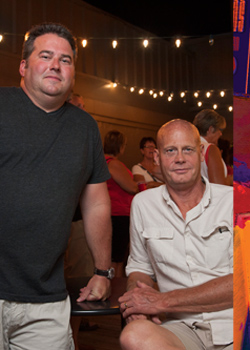 Not your typical Office Max, Excel offers used office furnishings from the likes of Herman Miller, Knoll, HON and Kimball. Its inventory is highly curated, emphasizing art deco, industrial and mid-century design, with a keen eye for aesthetics, which dovetails nicely with the art and décor scattered throughout the store. “I’m naturally a visual person,” Rouland explains, “so I like things that are pleasing to the eye. I think this has more of a designer look than your average used furniture store.”
Not your typical Office Max, Excel offers used office furnishings from the likes of Herman Miller, Knoll, HON and Kimball. Its inventory is highly curated, emphasizing art deco, industrial and mid-century design, with a keen eye for aesthetics, which dovetails nicely with the art and décor scattered throughout the store. “I’m naturally a visual person,” Rouland explains, “so I like things that are pleasing to the eye. I think this has more of a designer look than your average used furniture store.”
In one sense, Excel’s business model is a reflection of the post-recession turn toward sustainable reuse. “People really care about the repurpose [aspect],” he says. “It’s a genuine component of how people think nowadays. We are a third of the cost of ‘new,’ most of the time, so they can get high-quality furniture for much less than they could otherwise.”
As Excel builds relationships with more businesses, its storage facilities are quickly filling up. “Part of this business is buying in quantity, so you end up with a lot of [stuff],” Rouland explains. When a given piece is not right for the store, it’s donated to Habitat for Humanity’s ReStore outlet, conveniently located the next block over. “We’re not in the $20 chair business,” he notes wryly, “but we have a great relationship with Habitat. We just donated about 30 chairs… which they will sell for $20 or $30 each, which is great for them.”
Rediscovering the Past
Next door to Excel is another shop with an equally well-curated inventory. Operated by Jon and Angie Walker, Urban Artifacts features an eclectic mix of vintage antiques and objects from the 20th century. For Jon, the business brings his career interests full circle. “I’ve been buying and selling antiques since I was 10 years old,” he says. “My grandparents and mother were collectors and antique dealers. When I was still in grade school, I would travel around with them to antique shows and flea markets.”
One of the original dealers at the now-defunct Illinois Antique Center, Jon left that world for over a decade, but he and his wife were itching to get back in. “This store has been a concept in planning for probably 10 years,” Angie says. “We always said we wanted to do something on our own, but weren’t sure quite what. It finally seemed to be the right time—everything kind of came together.”
A collector himself, Jon was “always interested in advertising, toys… things that were visually cool,” he describes. “Old signs and coin-operated machines. Restored, old gas pumps.” These interests are apparent the moment you walk in the door. From a vintage jukebox and industrial-sized block letters to roomfuls of eclectic knickknacks and signs, signs, signs everywhere, Urban Artifacts is a museum of visual stimulation. True to its local-centric nature, the shop carries a selection of Peoria-related items and memorabilia, including customizable and historic signs, postcards, magnets and more. “I try to assemble original Peoria collectibles whenever possible… very iconic things that people remember,” says Jon, pointing at a sign from the old Sandy’s restaurant. “We will continue to carry more and more Peoria items.”
Having opened its doors just last summer, Urban Artifacts is well on its way to becoming one of the region’s go-to places for unique items. “We want to be that place people think of when they come to town,” Jon says, “where people can bring relatives or guests—a place where they can pick up something local. We want to be a destination.”
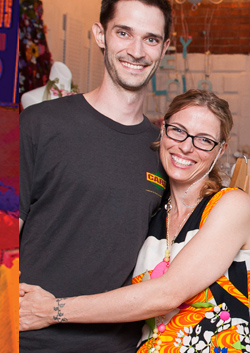 Upcycling the Neighborhood
Upcycling the Neighborhood
The proprietors of Hey Lola are no strangers to this neighborhood. As co-owners of Blue—the cozy bar on Main Street—Jessica and James McGhee have helped catalyze what is amounting to a long-term neighborhood renaissance. Leading by example, they sponsor monthly trash cleanups, work on beautification projects, and help tend to a community garden. “We’re really committed to the neighborhood,” Jessica explains.
Hey Lola carries a wide range of vintage clothing and “upcycled” trinkets, from eco-friendly jewelry to handmade soaps and candles, and like all the shops in the Sunbeam Building, it reflects its owner’s personality. “Most items are made in-house or by small companies that I hand-pick from around the country,” Jessica says. “I’m very particular—not only about the product… but who is making it and what their packaging looks like. And I have to like the people that run the company—that’s very important.”
Though it’s been open less than a year, Hey Lola is not a new venture. “I’ve been a small business owner for at least 10 years,” she notes. “I did this store at a different location in 2003… and I’ve been online with it since 2008.” Through tenacity and hard work, she’s turned her life’s passion into her livelihood—every entrepreneur’s goal.
Jessica’s husband also leases a studio in the building, where he operates James McGhee Photography. As the couple juggles their many ventures, they’ve managed to carve out a full-time living on their own terms. For Jessica, 2013 marks the first year she hasn’t had to cobble side jobs together to supplement her income—and she never seems to run out of colorful, recycled projects for Hey Lola.
21st-Century Shabby Chic
“I’ve been an interior decorator for 23 years,” says Lori Mabee, co-owner of Restoration at Studios on Sheridan, “and just kind of carried it into retail.” Whether people consult an expert or decorate their homes themselves, there is always a need for one-of-a-kind home accents. “That’s what this store is for.”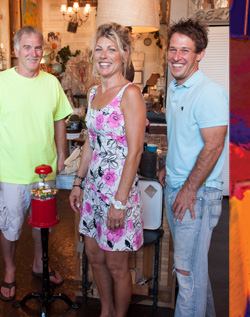
Indeed, wherever you look at Restoration, your eye will catch something of interest—a birdcage chandelier, a collection of vintage luggage, a refurbished floor lamp. One Yelp reviewer reveals some personal favorites: “candleholders that are real birch wood branches hollowed out to hold a candle, refinished tea trays to hold makeup or jewelry, Christmas garlands made out of folded pages from books, gift bags made from sweaters—you just have to see these things for yourself to decide what your favorites are!”
“I look at [Restoration] as ‘shabby chic,’ industrial, thinking outside the box,” explains Mabee, who opened the store in May of 2012 with Nicholas Bima and Don Schoch, all of whom are quick to share their expertise. “Come pick my brain—that’s why we’re here!” she exclaims. “We’ll give you free advice on how to decorate.” She appreciates the building’s creative atmosphere, which has proven to be the perfect fit for her business. “We think our stuff is so unique… we didn’t want to be in a strip mall.”
Mabee and her partners are always on the hunt for “new” vintage items, scouring estate sales and flea markets in search of pieces to transform into 21st-century shabby chic. “Every week, you’ll see new stuff,” she says. “We have just what you need to turn your house into a home.”
Drop By the Garage
If you’re creative but don’t know where to start, or if you’re just seeking a new challenge, a visit to the Art Garage might do the trick. “It’s a venue to enjoy art on a recreational level,” says owner Jessica Ball. “Our approach is to create a comfort zone where anyone can come in and enjoy the creative process.”
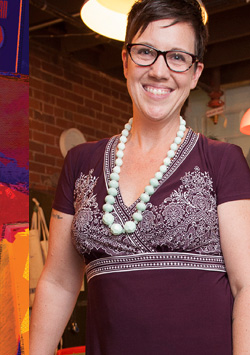 During “drop-in” hours, visitors can create their own art using the Art Garage’s materials and tools. “To keep things affordable, we started with… recyclable items like glass jars, glass bottles and cans, tile coasters,” Ball says. “As we grow, we’re able to get more advanced supplies—like canvases and artist-grade watercolors and acrylic paints—and try new projects and techniques.”
During “drop-in” hours, visitors can create their own art using the Art Garage’s materials and tools. “To keep things affordable, we started with… recyclable items like glass jars, glass bottles and cans, tile coasters,” Ball says. “As we grow, we’re able to get more advanced supplies—like canvases and artist-grade watercolors and acrylic paints—and try new projects and techniques.”
The Art Garage offers classes and workshops on a range of topics, from stained glass to painting, as well as themed activities like ladies nights, date nights and toddler time, and the easygoing atmosphere relieves the pressure of trying something new. “It’s informal, it’s fun, and it’s for all ages and abilities,” Ball says. “All the projects can be adapted to any level.”
Prior to opening the Art Garage, Ball had been a stay-at-home mom and freelance artist, but as her freelance work expanded, she began looking for a space to rent. Discovering the Sunbeam Building came as a pleasant surprise. “We [found] it by accident and just fell in love,” she explains. “What better place to do something like this than in the middle of… a creative-based building. That’s more than I could have planned for!”
Of Curiosity and Contemplation
Robin Albright wants to put more “happy” in your life. The certified career coach and owner of Zinger Zanger Inc. believes that people instinctively know their own answers, but sometimes require a coach to help pull the answers out of them. The unique consulting firm offers one-on-one life and business coaching, as well as seminars and workshops designed to extract that latent sense of purpose.
“If a company has a lot of transitions going on, and employees who are frustrated because things aren’t the way they used to be… I connect [them] back to why they’re there in the first place,” Albright explains. “I help them visually connect with what they want… and help them brainstorm ways to get there.”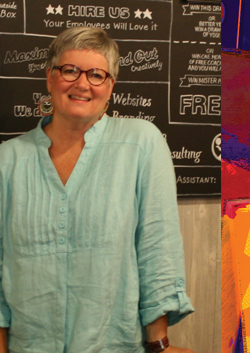
With her son Tobey Albright on board as creative director, she’s infused the business with an unmistakably quirky vibe. The Zinger Zanger Office of Curiosity and Contemplation, as it’s been dubbed, is filled with works of art as idiosyncratic as the name. There’s a story behind each piece, and Albright welcomes anyone to walk in and strike up a conversation.
Before finding the Sunbeam, she would meet with clients at coffee shops and the like, but “this is much more professional”—and she’s thrilled to be located amongst the building’s artists. “It’s full of creativity,” she declares, “and that, I believe, is the juicy part of life. “To be creative, you’ve got to be willing to be different. You have to be able to step outside the box to help people see things differently.” That, says Albright, is what Zinger Zanger brings to the table. “I love what I do. I really get to look at people and see what’s amazing about them.”
Artists on Sheridan
In addition to the gallery at its center, which highlights local and regional artwork, Studios on Sheridan houses 15 to 20 artists in an assortment of studios—the impetus for developing the building in the first place. From painters to photographers to glass artists, each operates a business of some sort, their creative work at the heart of the Sunbeam Building’s unique atmosphere.
Rebecca Draland-Doyle, a painter, was among the first to sign on. “I liked the location,” she says, “and the idea of having retail… indicated to me there would be a bit more foot traffic. It’s an interesting mix of businesses, and it all works together. The foot traffic goes back and forth between the art studios and the retail… We all support each other.”
Just a few months ago, glass artist Jeremie Draper moved her business, J Draper Glass, into Studios on Sheridan. “I needed more space to pursue bigger, more complex pieces,” she explains. “The space is perfect, surrounded by a plethora of talented artisans—a community of people to share ideas.” Draper, until recently a full-time caterer for Echo Valley Meats, is transitioning into a part-time role as she takes her passion for glass to the next level.
Connie Andrews shares a studio with fellow portrait artist Gloris Young, just down the hall from the Art Garage, where she also teaches classes. “It’s a neat neighborhood… [and] what they’ve turned this building into is awesome,” says the full-time artist, who once ran an auto upholstery business. Andrews is enthusiastic about the state of Peoria’s arts scene. “It’s exciting there’s so much art going on… I think First Fridays have really helped to establish that.”
Indeed, First Fridays—the monthly studio tour sponsored by the artist group CIAO—has ensured a growing contingent of traffic each month. “First Fridays has been a huge boon to our businesses and exposure for the building, and I am eternally grateful for that,” says Steve Rouland. “The synergy has been great. I don’t think we could have imagined [when we started] that this is what we were creating.”
To be sure, the arts are a critical element in creating the vibrancy that defines the Sunbeam Building. “Everybody has really stepped up their game because they can see the potential,” notes Jon Walker of this interplay between business and the arts. Rouland agrees. “I think [it] has raised the bar for what can be done.”
The Rising Tide
Once under disrepair, the neighborhood near Main and Sheridan is in the midst of an ongoing revitalization, driven by bottom-up localism and bolstered by the creativity of the arts. Not only has a sense of community developed within the Sunbeam Building, it’s also developed around it, where a trip to the neighborhood might include a stop at Broken Tree Coffee or The Main Statement, a visit to the Backspace art gallery, or drinks at Blue or Pitch Karaoke Bar. It’s truly a case of “a rising tide raising all boats,” as Rouland suggests.
“I feel we landed on Main Street at the right time,” he says. “There was already an upswing. The city had spent money on infrastructure and the [adjacent] parking lot. With the street improvements and the [Peoria NEXT] Innovation Center… there were things in place that made it a little easier for us.” And Rouland is quick to credit Steve Spain, long-time owner of The Costume Trunk, for his commitment. “Steve’s the pioneer. He’s been the anchor on this part of Main Street for a long time.”
The future, it seems, has never been brighter. With each new shop, with every artist and business owner who moves in, the synergies multiply. At the center of it all is the Sunbeam Building, a showcase for how business and the arts can work together to breathe life into a neighborhood. The flexibility, dynamism and entrepreneurial spirit within reflect many of the new ways of working in the 21st century, and it all came together organically: through creativity, collaboration and hard work. As the region looks to the arts to help catalyze future growth, it’s a model to take to heart. iBi
The Prairie Traveling Vintage Show will make a return visit to the Sunbeam Building in November. Call (309) 657-9238 or find Studios On Sheridan on Facebook for the latest updates.


